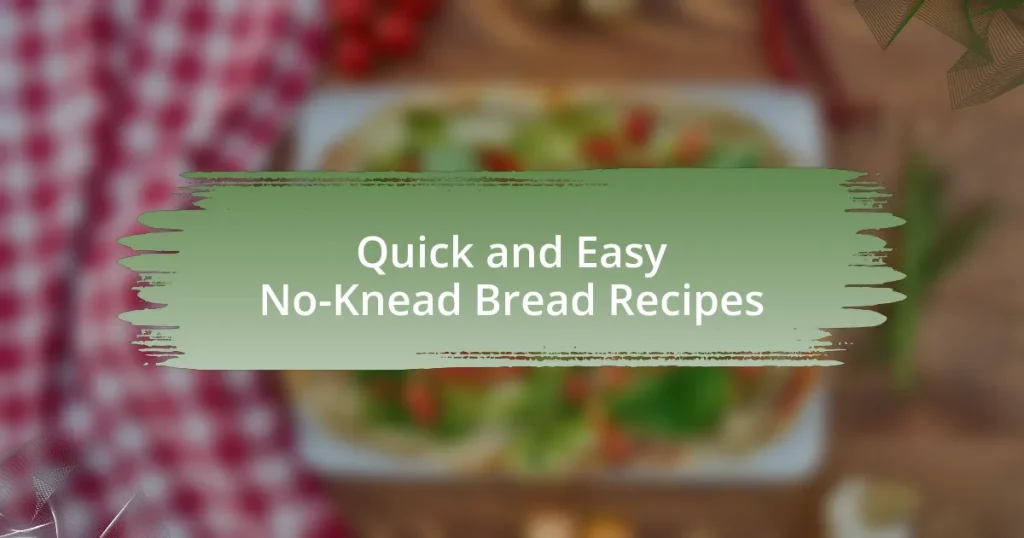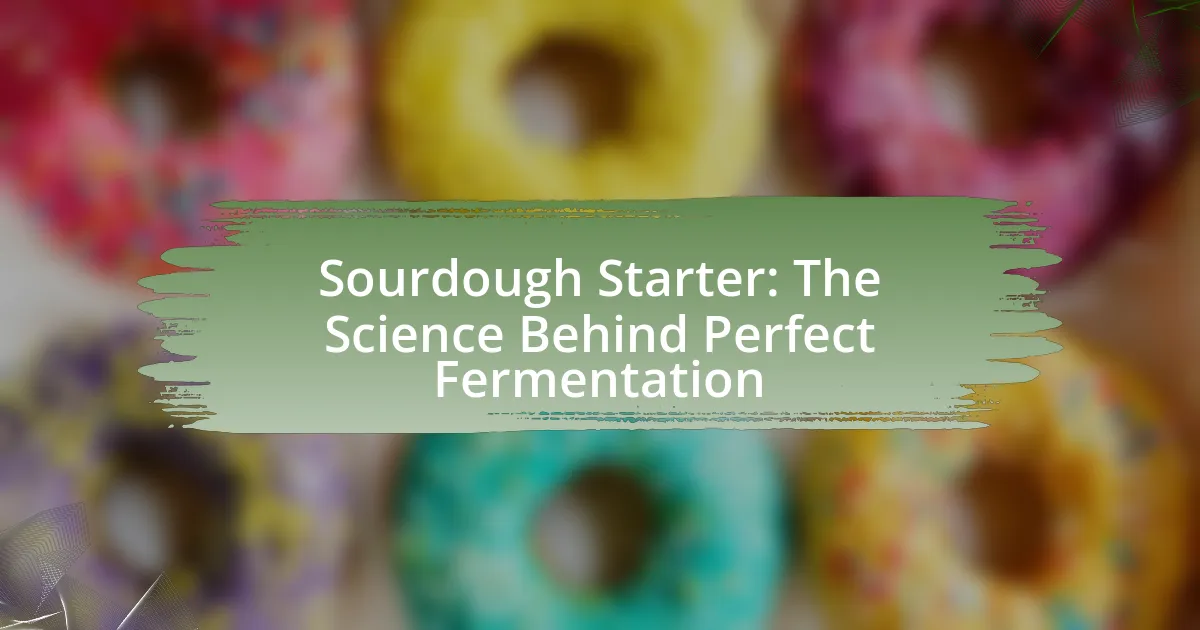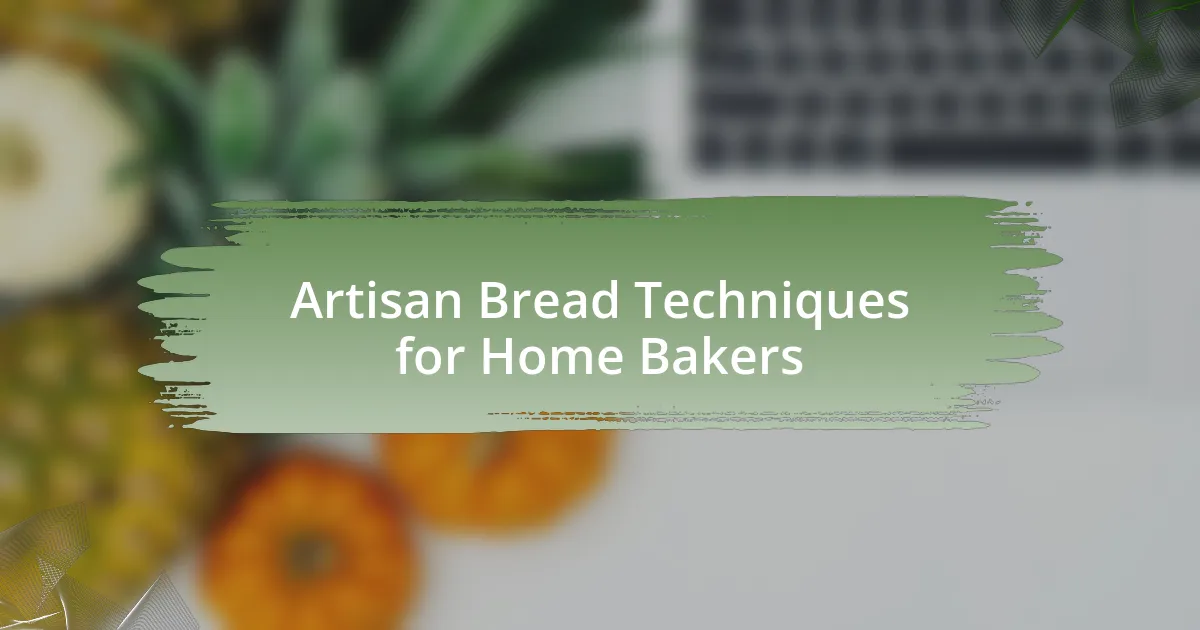Quick and easy no-knead bread recipes provide a simplified approach to bread-making, requiring minimal effort and no traditional kneading. These recipes rely on a long fermentation process, typically lasting 12 to 18 hours, to develop gluten naturally, resulting in a crusty, artisan-style loaf with a chewy interior. Key ingredients include flour, water, yeast, and salt, with variations in flour types affecting the bread’s texture. The article explores the techniques, benefits, and common mistakes associated with no-knead bread, along with popular recipes and tips for enhancing flavor and texture. Additionally, it addresses troubleshooting methods for common baking issues and creative ways to utilize leftover bread.
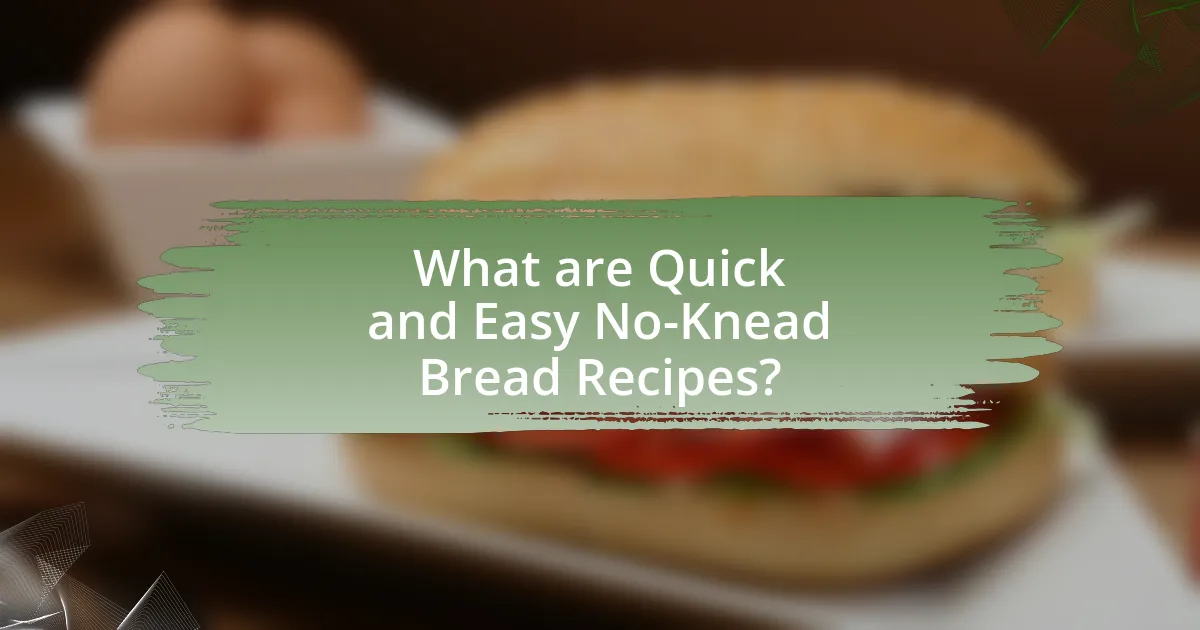
What are Quick and Easy No-Knead Bread Recipes?
Quick and easy no-knead bread recipes are methods for making bread that require minimal effort and no traditional kneading. These recipes typically involve mixing flour, water, yeast, and salt, allowing the dough to rise for an extended period, often overnight, which develops gluten naturally. The simplicity of these recipes is supported by the fact that they often yield a crusty, artisan-style loaf with a chewy interior, making them popular among home bakers.
How do no-knead bread recipes differ from traditional bread recipes?
No-knead bread recipes differ from traditional bread recipes primarily in the method of dough preparation, as they require minimal handling and no kneading. Traditional bread recipes typically involve kneading the dough to develop gluten, which contributes to the bread’s structure and texture. In contrast, no-knead recipes rely on a longer fermentation period, often 12 to 18 hours, allowing gluten to develop naturally through time rather than mechanical action. This method results in a bread that is often more rustic in appearance and has a chewy texture, while traditional methods yield a finer crumb and a more uniform shape. The effectiveness of the no-knead technique is supported by the work of Jim Lahey, who popularized this method, demonstrating that extended fermentation can produce high-quality bread without the need for kneading.
What techniques are used in no-knead bread making?
No-knead bread making primarily utilizes the techniques of long fermentation and minimal mixing. Long fermentation, typically lasting 12 to 18 hours, allows gluten to develop naturally without the need for kneading, resulting in a chewy texture and complex flavor. Minimal mixing involves combining flour, water, salt, and yeast until just incorporated, which reduces the need for physical manipulation. This method relies on time rather than effort, as the dough is left to rise and develop flavor through slow fermentation.
Why is kneading not required in these recipes?
Kneading is not required in these recipes because the dough relies on a long fermentation process to develop gluten structure. In no-knead bread recipes, the combination of time and hydration allows the gluten to form naturally without the need for manual kneading. This method typically involves mixing the ingredients and allowing the dough to rest for an extended period, often 12 to 18 hours, which enhances flavor and texture while promoting gluten development through a process called autolyse.
What are the key ingredients in no-knead bread recipes?
The key ingredients in no-knead bread recipes are flour, water, yeast, and salt. Flour serves as the primary structure, while water hydrates the flour and activates the yeast. Yeast is essential for fermentation, allowing the dough to rise, and salt enhances flavor and controls yeast activity. These ingredients combine to create a simple yet effective method for making bread without the need for kneading, relying instead on long fermentation to develop gluten and flavor.
How do different types of flour affect the bread’s texture?
Different types of flour significantly affect the texture of bread. For instance, bread flour, which has a higher protein content (around 12-14%), creates a chewier texture due to increased gluten formation, making it ideal for yeast breads. In contrast, all-purpose flour, with a moderate protein content (about 10-12%), yields a softer texture, suitable for a variety of baked goods but less chewy than bread made with bread flour. Whole wheat flour, containing the entire grain, results in denser bread with a nuttier flavor and a coarser texture due to the bran and germ. Additionally, cake flour, which has a lower protein content (around 7-9%), produces a tender and soft crumb, making it unsuitable for yeast breads but perfect for cakes and pastries. These variations in protein content and grain structure directly influence the gluten development and, consequently, the final texture of the bread.
What role does water play in no-knead bread recipes?
Water is essential in no-knead bread recipes as it hydrates the flour, activating gluten development and enabling fermentation. This hydration process allows the dough to rise without the need for kneading, resulting in a light and airy texture. The presence of water also facilitates the enzymatic activity that breaks down starches into sugars, which yeast then ferments, producing carbon dioxide and contributing to the bread’s structure and flavor.
What are the benefits of making no-knead bread?
Making no-knead bread offers several benefits, including simplicity, time efficiency, and improved flavor. The method requires minimal hands-on time, allowing for a more relaxed baking experience, as the dough can rise unattended for extended periods. This long fermentation process enhances the bread’s flavor and texture, resulting in a crusty exterior and a chewy interior. Additionally, no-knead bread typically requires fewer ingredients and less equipment, making it accessible for novice bakers. The ease of preparation and the high-quality results make no-knead bread a popular choice among home bakers.
How does no-knead bread save time in the baking process?
No-knead bread saves time in the baking process by eliminating the need for extensive manual kneading, which typically requires 10 to 15 minutes. Instead, this method relies on a long fermentation period, allowing the dough to develop gluten structure naturally over 12 to 18 hours. This extended rise time not only enhances flavor but also reduces active preparation time, making it more convenient for bakers. The simplicity of mixing ingredients and letting them rest means that bakers can prepare the dough with minimal effort and then focus on other tasks while it rises.
What are the flavor advantages of no-knead bread?
No-knead bread offers enhanced flavor advantages primarily due to its long fermentation process. This extended fermentation allows for the development of complex flavors and aromas, resulting in a richer taste profile compared to traditional kneaded bread. The slow rise encourages the growth of beneficial bacteria and yeast, which contribute to a more nuanced flavor. Additionally, the Maillard reaction during baking creates a deeper crust color and flavor, further enhancing the overall taste experience.
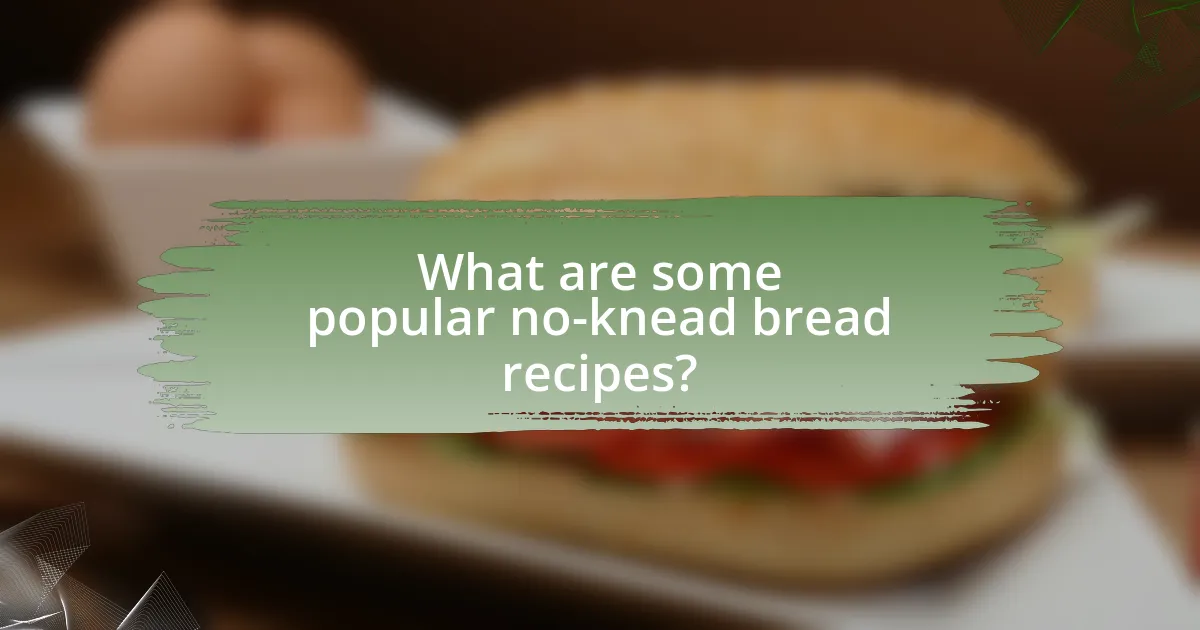
What are some popular no-knead bread recipes?
Some popular no-knead bread recipes include the classic no-knead artisan bread, which requires just flour, water, salt, and yeast, and is known for its crusty exterior and chewy interior. Another favorite is the no-knead whole wheat bread, which incorporates whole wheat flour for a nuttier flavor and denser texture. Additionally, no-knead focaccia is popular for its olive oil richness and customizable toppings, while no-knead sourdough offers a tangy flavor profile achieved through a long fermentation process. These recipes are favored for their simplicity and minimal hands-on time, making them accessible for home bakers.
How can I make a basic no-knead bread?
To make a basic no-knead bread, combine 3 cups of all-purpose flour, 1.5 teaspoons of salt, and 0.5 teaspoons of instant yeast in a large bowl. Add 1.5 cups of warm water and stir until a shaggy dough forms. Cover the bowl with plastic wrap and let it rest at room temperature for 12 to 18 hours, until the surface is bubbly and the dough has doubled in size. After resting, turn the dough out onto a floured surface, shape it into a ball, and let it rest for 15 minutes. Preheat the oven to 450°F (232°C) and place a Dutch oven inside to heat. Once heated, carefully transfer the dough into the Dutch oven, cover it, and bake for 30 minutes. Remove the lid and bake for an additional 15 to 30 minutes until the bread is golden brown. This method is validated by the popularity of no-knead bread recipes, which emphasize simplicity and minimal effort while achieving a crusty, artisan-style loaf.
What steps are involved in preparing the dough?
To prepare the dough for quick and easy no-knead bread, follow these steps: first, combine the dry ingredients, which typically include flour, salt, and yeast, in a large mixing bowl. Next, add water to the dry mixture, stirring until a shaggy dough forms. This dough should be wet and sticky, which is essential for the no-knead method. After mixing, cover the bowl with plastic wrap or a clean kitchen towel and let it rest at room temperature for 12 to 18 hours, allowing the dough to rise and develop flavor. Finally, after the resting period, shape the dough gently on a floured surface and prepare it for baking. This method relies on the long fermentation process to develop gluten without kneading, resulting in a light and airy bread.
How long should the dough rest before baking?
Dough should rest for at least 12 to 18 hours before baking. This resting period allows for proper fermentation, which enhances flavor and texture. According to a study published in the Journal of Food Science, longer resting times improve the dough’s gluten structure, resulting in a better rise and crumb in the final bread product.
What variations exist for no-knead bread recipes?
Variations for no-knead bread recipes include different types of flour, added ingredients, and flavor enhancements. Common flour variations are whole wheat, rye, and gluten-free options, which alter the texture and nutritional profile. Added ingredients such as herbs, cheese, nuts, or seeds can enhance flavor and texture, while flavor enhancements like garlic, olives, or dried fruits introduce unique tastes. These variations allow for customization based on dietary preferences and desired outcomes, making no-knead bread versatile and adaptable for various palates.
How can I incorporate herbs and spices into my no-knead bread?
To incorporate herbs and spices into no-knead bread, mix dried herbs or spices directly into the dry ingredients before adding water. Common options include rosemary, thyme, garlic powder, or paprika, which enhance flavor without altering the bread’s texture. For instance, adding one to two tablespoons of dried herbs or one teaspoon of spices per batch can significantly elevate the taste. This method is effective because the dry ingredients allow for even distribution, ensuring that the flavors infuse throughout the bread during the fermentation process.
What are some popular add-ins for no-knead bread?
Popular add-ins for no-knead bread include herbs, cheese, nuts, seeds, and dried fruits. These ingredients enhance flavor and texture, making the bread more versatile. For example, adding rosemary or thyme can impart a savory note, while incorporating cheese like cheddar or feta adds richness. Nuts and seeds, such as walnuts or sunflower seeds, contribute crunch and nutritional value. Dried fruits like cranberries or raisins introduce a hint of sweetness, creating a balanced flavor profile.
What are some common mistakes to avoid when making no-knead bread?
Common mistakes to avoid when making no-knead bread include using too much flour, not allowing enough fermentation time, and neglecting proper hydration. Excess flour can lead to a dense loaf, as the dough needs to be wet for optimal gluten development. Insufficient fermentation time can result in a lack of flavor and poor texture; typically, a minimum of 12 to 18 hours is recommended for the dough to rise adequately. Additionally, neglecting hydration can prevent the bread from achieving its characteristic open crumb structure, as no-knead bread relies on a wet dough to create air pockets during baking.
How can over-proofing affect the final product?
Over-proofing can lead to a final product that is overly airy and lacks structure. When dough is over-proofed, the yeast consumes too much sugar, resulting in a breakdown of gluten and a loss of elasticity. This can cause the bread to collapse during baking, leading to a dense texture and uneven crumb. Studies show that optimal proofing times are crucial for achieving the desired rise and texture in bread, as over-proofed dough fails to hold its shape and can result in a flat loaf.
What should I watch for to ensure proper baking?
To ensure proper baking, monitor the oven temperature closely, as accurate heat is crucial for achieving the desired texture and rise in no-knead bread. An oven thermometer can confirm that the temperature matches the setting, which is typically around 450°F (232°C) for bread. Additionally, observe the bread’s color and crust formation; a golden-brown crust indicates that the bread is likely baked through. The internal temperature of the bread should reach approximately 190°F (88°C) for optimal doneness. These factors collectively ensure that the bread bakes evenly and develops the right flavor and structure.
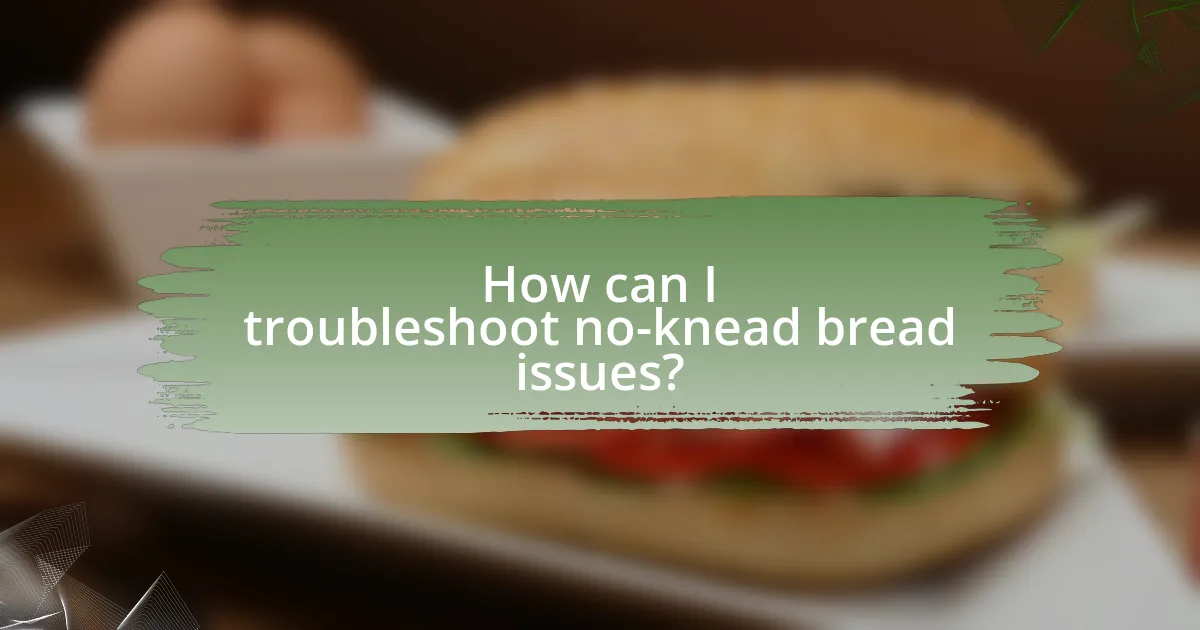
How can I troubleshoot no-knead bread issues?
To troubleshoot no-knead bread issues, first assess the hydration level of your dough; too much water can lead to overly sticky bread, while too little can result in a dry texture. Adjust the water content based on the flour type and humidity in your environment, as different flours absorb water differently. Additionally, ensure that your yeast is fresh and active, as expired yeast can prevent proper rising. If your bread is dense, consider extending the fermentation time to allow for better gluten development. Lastly, check your baking temperature; an oven that is not hot enough can lead to undercooked bread. These adjustments are supported by baking science, which emphasizes the importance of ingredient ratios and fermentation in achieving optimal bread texture and flavor.
What are the signs of undercooked no-knead bread?
The signs of undercooked no-knead bread include a doughy texture in the center, a pale crust, and a lack of a hollow sound when tapped on the bottom. When the bread is cut, if the interior appears wet or gummy, it indicates insufficient cooking. Properly baked no-knead bread should have a golden-brown crust and a fully set crumb structure.
How can I fix a dense loaf of no-knead bread?
To fix a dense loaf of no-knead bread, increase the hydration level by adding more water to the dough. A higher water content allows for better gluten development and air pockets, which contribute to a lighter texture. Typically, no-knead bread recipes call for a hydration level of around 70% to 80%. If your loaf is dense, consider adjusting the water to achieve this range, ensuring that the flour is fully hydrated. Additionally, allow for a longer fermentation time, as this can enhance the bread’s rise and texture.
What should I do if my bread doesn’t rise properly?
If your bread doesn’t rise properly, check the yeast’s freshness and ensure it is activated correctly. Yeast should be within its expiration date and should foam when mixed with warm water and sugar, indicating it is alive. Additionally, verify that the dough is kept in a warm, draft-free environment, as temperatures below 70°F can hinder rising. If the dough still fails to rise, consider adjusting the hydration level, as too little water can lead to dense bread.
What tips can help improve my no-knead bread baking experience?
To improve your no-knead bread baking experience, ensure you use the right flour type, such as bread flour, which has a higher protein content that enhances gluten development. Additionally, allow for adequate fermentation time, typically 12 to 18 hours, as this promotes flavor and texture. Maintaining the correct hydration level, around 70% to 75%, is crucial for achieving a moist crumb. Using a preheated Dutch oven can create steam, resulting in a crusty exterior. Lastly, avoid over-mixing the dough; simply combine until no dry flour remains to prevent a dense loaf. These practices are supported by baking science, which emphasizes the importance of flour quality, fermentation, hydration, and cooking methods in bread making.
How can I achieve a crustier exterior on my no-knead bread?
To achieve a crustier exterior on your no-knead bread, bake it in a preheated Dutch oven. The enclosed environment traps steam released from the dough, which helps create a crispy crust. Research indicates that baking bread in a covered pot can increase moisture retention, leading to a better crust formation. Additionally, using a higher baking temperature, around 450°F (232°C), enhances the Maillard reaction, which contributes to browning and crust development.
What storage methods work best for no-knead bread?
The best storage methods for no-knead bread include wrapping it in a clean kitchen towel and placing it in a paper bag, or storing it in an airtight container at room temperature. These methods help maintain the bread’s crust while preventing it from becoming stale. Research indicates that bread stored in a paper bag retains its texture and flavor better than bread stored in plastic, which can trap moisture and lead to sogginess. Additionally, for longer storage, freezing no-knead bread is effective; wrapping it tightly in plastic wrap and then in aluminum foil can preserve its quality for up to three months.
What are the best practices for enjoying no-knead bread?
To enjoy no-knead bread, it is essential to allow it to cool completely before slicing, as this enhances texture and flavor. Cooling prevents steam from making the bread gummy, ensuring a crusty exterior and a soft interior. Additionally, pairing no-knead bread with high-quality olive oil or butter elevates the tasting experience, as these condiments complement the bread’s rustic flavor. Serving the bread with fresh herbs, cheeses, or spreads can further enhance its enjoyment, providing a variety of flavors and textures.
How can I pair no-knead bread with meals or toppings?
No-knead bread pairs well with a variety of meals and toppings, enhancing both flavor and texture. For instance, it complements soups and stews, providing a hearty base for dipping. Additionally, it serves as an excellent accompaniment to cheese and charcuterie boards, where its crusty exterior contrasts with creamy cheeses and savory meats. Toppings such as olive oil, balsamic vinegar, or flavored butters can elevate the bread’s taste, making it suitable for appetizers or snacks. The versatility of no-knead bread allows it to be enjoyed with breakfast items like avocado toast or as a side for salads, showcasing its adaptability across different cuisines.
What are some creative ways to use leftover no-knead bread?
Leftover no-knead bread can be creatively repurposed in several ways. One effective method is to transform it into croutons by cutting the bread into cubes, tossing them with olive oil and seasonings, and baking until crispy. This process enhances salads and soups. Another option is to make bread pudding, where the stale bread is combined with a mixture of eggs, milk, sugar, and spices, then baked until set, creating a delicious dessert. Additionally, leftover bread can be used for French toast by soaking slices in a mixture of eggs and milk, then frying them until golden brown, providing a hearty breakfast. These methods utilize the bread effectively, reducing waste while creating new dishes.
